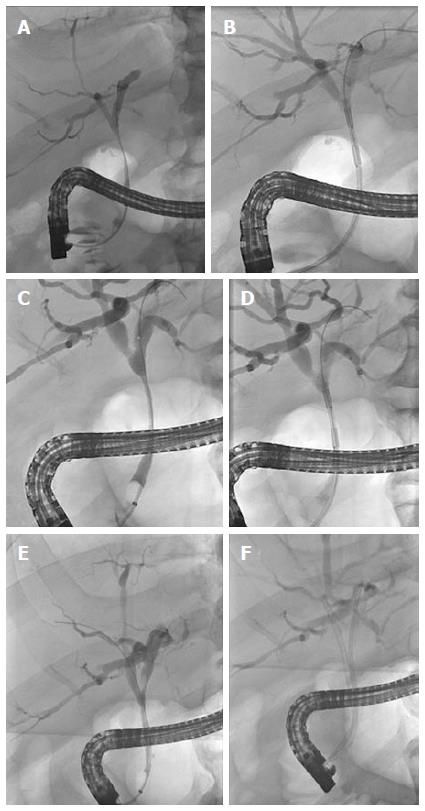Copyright
©The Author(s) 2015.
World J Gastrointest Endosc. Jun 25, 2015; 7(7): 675-687
Published online Jun 25, 2015. doi: 10.4253/wjge.v7.i7.675
Published online Jun 25, 2015. doi: 10.4253/wjge.v7.i7.675
Figure 5 Effect of repeated endoscopic retrograde cholangiopancreatography-directed radiofrequency ablation on a malignant extrahepatic biliary stricture in a patient with unresectable cholangiocarcinoma.
A long perihilar stricture is seen involving the extrahepatic duct (A) in a patient who had exploratory laparotomy that showed locally advanced and unresectable Bismuth I cholangiocarcinoma. A cholecystectomy had been performed at the time of laparotomy. Endoscopic retrograde cholangiopancreatography (ERCP)-directed radiofrequency ablation (RFA) was applied to this malignant stricture (B) followed by biliary stenting (not shown). Following two rounds of RFA done at about 3 mo intervals, a third ERCP showed moderate improvement in the stricture’s diameter (C). Repeat ERCP-directed RFA was performed (D). After 4 rounds of RFA therapy, an ERCP 1 year later showed marked improvement of the extrahepatic bile duct with no high-grade stricture seen (E), and RFA was not repeated during this procedure. A 10-Fr plastic stent was placed into the right hepatic duct and a 7-Fr plastic stent was placed into the left hepatic duct for more durable biliary drainage (F), as this was an otherwise healthy patient with excellent functional status who would likely outlive metal stenting. While patients with Bismuth I cholangiocarcinoma often do well with a single extrahepatic biliary stent, this patient had previously had premature stent failure and cholangitis with a single plastic stent, thus two biliary stents were required.
- Citation: Uppal DS, Wang AY. Advances in endoscopic retrograde cholangiopancreatography for the treatment of cholangiocarcinoma. World J Gastrointest Endosc 2015; 7(7): 675-687
- URL: https://www.wjgnet.com/1948-5190/full/v7/i7/675.htm
- DOI: https://dx.doi.org/10.4253/wjge.v7.i7.675









